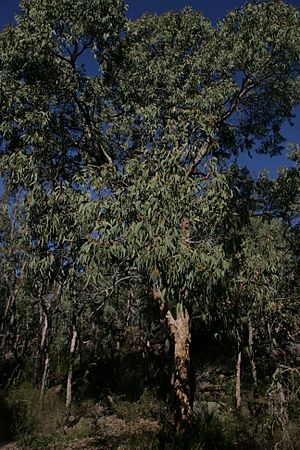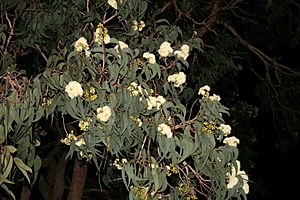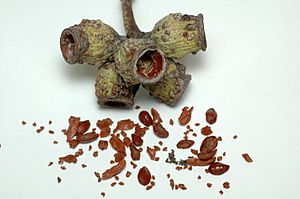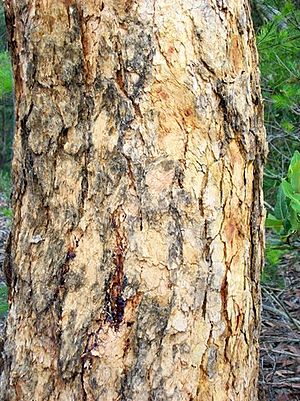Yellow bloodwood facts for kids
Quick facts for kids Yellow bloodwood |
|
|---|---|
 |
|
| Yellow bloodwood at Arcadia | |
| Scientific classification | |
| Genus: |
Corymbia
|
| Species: |
eximia
|
| Synonyms | |
|
|


The Yellow Bloodwood (Corymbia eximia) is a special tree found only in New South Wales, Australia. It's known for its unique yellow-brown bark that looks like a puzzle. This tree often grows in areas with lots of rain, on rocky sandstone soils. You can find it on high flat areas called plateaux or on steep slopes called escarpments. It's also good at surviving bushfires.
Yellow Bloodwood trees can grow up to 20 meters (about 65 feet) tall. Their leaves are thick and greyish-green, shaped like a spear or a sickle. In spring, they produce creamy white flowers that grow in bunches of seven. For many years, this tree was called Eucalyptus eximia. But in 1995, scientists Ken Hill and Lawrie Johnson moved it to a new group of trees called Corymbia.
Contents
What Does Yellow Bloodwood Look Like?
The Yellow Bloodwood is a beautiful tree with a twisted, gnarled shape. It can grow up to 20 meters (65 feet) tall. If it grows in a windy, open spot, it might be shorter and have many trunks.
Its Special Bark
The bark is very unique. It's a yellowish-fawn color and feels rough and flaky. It has a pattern that looks like many small, flat pieces fitted together, which is called "tessellated."
Leaves and Flowers
The adult leaves are greyish-green, thick, and have many visible veins. They are shaped like a spear (lanceolate) or a sickle (falcate). They can be up to 20 centimeters (8 inches) long. A raised yellow line runs down the middle of each leaf. The leaves are the same color on both sides.
The creamy white flowers start as buds in February. They open from August to October. These flowers are sometimes used in flower arrangements. Seven flowers grow together in a cluster called a panicle. The buds are pear or club-shaped.
Gumnuts and Seeds
After the flowers, the tree produces gumnuts. These are shaped like an urn, which is common for bloodwood trees. The seeds inside don't have wings. They are ready by December and can stay on the tree for up to 16 months.
Young Trees
Young Yellow Bloodwood trees have different leaves. The first few pairs of leaves grow opposite each other and are oval or spear-shaped. Later, the leaves become more oblong or spear-shaped and grow alternately along the stems. These young leaves are a light blue-green color.
How Yellow Bloodwood Got Its Name
The Yellow Bloodwood was first found by European explorers near the Grose River in 1803. A German botanist named Johannes Conrad Schauer officially described it in 1843. He named it Eucalyptus eximia.
The word "eximia" comes from a Latin word meaning "exceptional" or "uncommon." This name might have been chosen because of the tree's unusual bark or its striking flowers.
Changing Names
In 1995, scientists Ken Hill and Lawrie Johnson decided to split the large Eucalyptus group into three smaller groups. They moved E. eximia into a new group called Corymbia. This is why the tree is now called Corymbia eximia.
The common name "yellow bloodwood" comes from the red-brown sap, or "gum veins," found in the wood. This sap looks a bit like blood.
Where Yellow Bloodwood Lives
The Yellow Bloodwood grows in central New South Wales. You can find it from Howes Valley in the north down to Tolwong in the south. It's very common around the Sydney Basin.
Its Home Environment
It likes to grow on sandstone plateaux and steep slopes near the Nepean and Hawkesbury Rivers. It's also found in the lower Blue Mountains. These trees prefer dry sclerophyll forests on sandstone soils. They can grow at heights up to 500 meters (about 1,640 feet) above sea level. They need a good amount of rain each year.
The Yellow Bloodwood often grows alongside other native trees. These include the Red Bloodwood, Dwarf Apple, and Smooth-barked Apple.
Yellow Bloodwood and Nature
The Yellow Bloodwood is very tough. After a bushfire, it can regrow from special buds hidden under its bark. These trees can live for over a hundred years.
Animals also interact with the tree. For example, the grey-headed flying fox (a type of large bat) likes to eat its flowers.
How People Use Yellow Bloodwood
Because the Yellow Bloodwood is not very big and not super common, it wasn't often used for timber.
However, its attractive bark and smaller size make it a good choice for planting in cities. It's used as a street tree in some Australian cities. It's also a nice tree for backyards, though it might be too big for very small gardens. It produces many flowers, but they don't last for a very long time.
A smaller version of the tree, called "nana," has been grown. This smaller form is even better for gardens or as a street tree.
See also
 In Spanish: Palo de sangre amarillo para niños
In Spanish: Palo de sangre amarillo para niños


